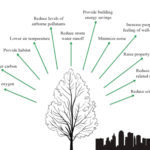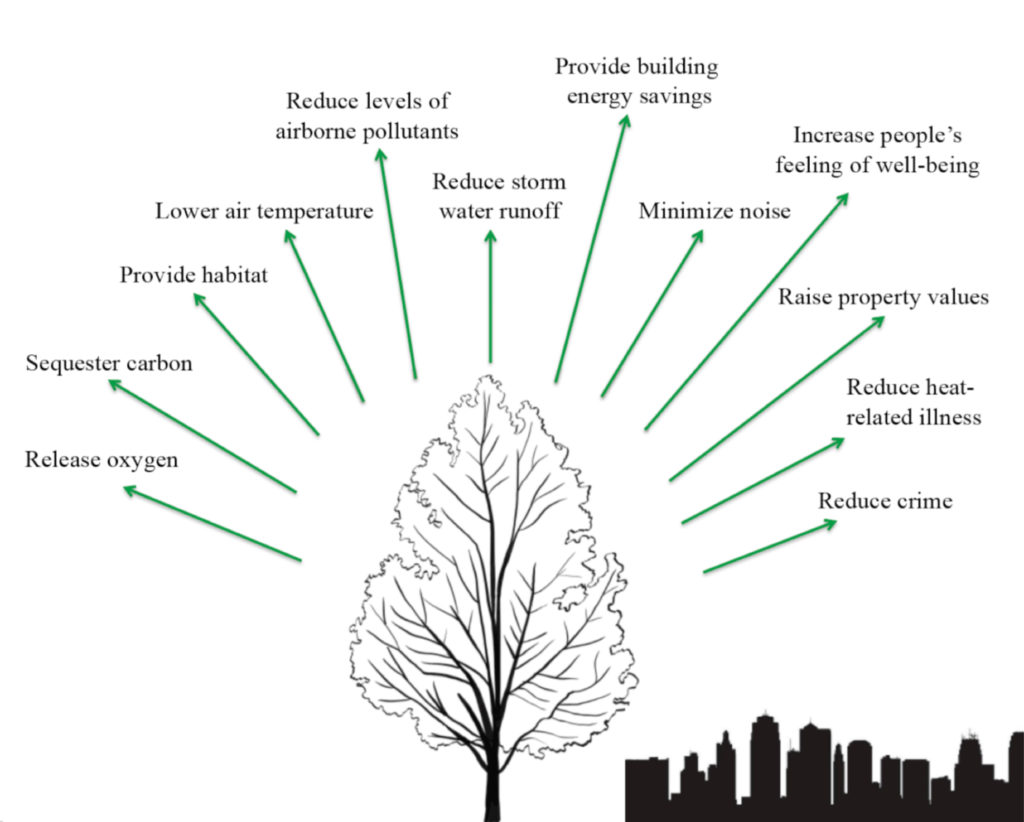
By Florence DiTirro
The National Land Cover Database from 2001 estimated Belmont’s tree canopy was 27% of Belmont’s land. From 2003 to 2008, Boston’s urban tree cover declined from 29% to 28%.
This downward trend continues if we look at our state, our country, and our globe. The Massachusetts urban tree cover declined between 0.32% and 0.24% in the five years from 2009 to 2014, and the United States overall lost 1.0% of urban tree cover. Global loss was measured as -0.2%.
It’s a sad state that we are losing our trees. What is there not to like about trees? And they do so much for us. The loss of tree cover is accompanied by the loss of the trees’ environmental, economic, and societal benefits.
Multiple benefits of tree cover
The urban tree canopy is the layer of tree leaves, branches, and stems that covers the ground when viewed from above. The urban tree canopy is especially important in urban environments with large impervious surfaces, such as asphalt and concrete, which store large amounts of heat during the day. These places are referred to as urban heat islands.
Trees’ shade and respiration cool the area around them, reducing the temperature of urban heat islands, lowering energy costs, and improving quality of life. The tree canopy also intercepts rainfall that otherwise would run off pavement and wash surface pollutants into local waters.
One benefit of trees that we hear about is their ability to sequester carbon. Carbon sequestration is the absorption and storage of carbon. Plants take in carbon dioxide (CO2) from the atmosphere and through photosynthesis use the CO2 to produce carbohydrates. These carbohydrates are stored by the tree until they are needed for energy, growth, and other metabolic processes. Storing carbon in trees reduces the amount of carbon in our atmosphere, which helps to mitigate the greenhouse effect, a factor in global warming and climate change.
Even a young tree removes an average of 13 pounds of carbon dioxide from our atmosphere annually. By 10 years of age, a tree can absorb 48 pounds of carbon dioxide per year.
Besides carbon, plants absorb other common chemical pollutants found in the air. These include the byproducts of refining and burning petroleum products, such as sulfur dioxide, ozone, and nitrogen oxides.
Small particulate matter in the air produced by power plants and factories burning fossil fuels can also be absorbed and stored in leaf tissue. Larger particles that land on the surface of a leaf can be retained on the outside of a leaf until the next rain washes it onto the ground or the leaf falls from the tree. Even though this kind of pollution is a major factor in developing nations, the eastern United States also has a moderate level of particulate matter in the air. Both particulate matter and inhaled pollutants (nitrogen oxides, sulfur dioxide) contribute to cardiovascular and respiratory illnesses, including asthma.
Studies show that deciduous tree cover can reduce rainfall intensity by 20%, and evergreen canopy by 30%. Reducing rain intensity has two benefits. It allows water to slowly seep into the ground to renew groundwater, thus providing water for plants over a long period and reducing the threat of drought. It also slows down the stormwater, which along with the soil-stabilizing effect of tree roots, prevents erosion and runoff and ultimately can lessen flooding.
On sunny days, an evergreen tree can block 90% of the sun’s light, and a deciduous tree can block 35% to 45%. Planted properly around a building, trees reduce the cost of cooling in the summer and heating in the winter.
Trees also lower the ambient air temperature. Heat from solar radiation has to be stored somewhere. While the wind may carry away some of the heat, tree leaves and the animals they harbor can reduce available heat via evaporation, which locks up energy in the phase change from liquid to vapor.
Urban heat islands can be 3.6oF warmer during the day than nearby countryside. At night the difference is even greater because heat stored in urban pavements is released into the atmosphere. It has been shown that trees can reduce the air temperature in urban heat islands by 1o to 3.5oF on a summer day. Since it is predicted that our summers will become warmer, 1o to 3oF can make a difference. High temperature exposure can lead to dehydration, heat exhaustion and other acute heat-related illnesses, most seriously, heat stroke. High ambient temperatures also increase the risk of heart attack and stroke in the elderly.

Benefits of urban trees as listed in “Planting for Resilience: Selecting Urban Trees in Massachusetts,” a talk by Ashley McElhinney.
Environmental scientists have determined the economic value of urban trees. Nationally our 5.5 billion urban trees are valued as:
- $5.4 billion for air pollution removal
- $5.4 billion for energy conservation
- $4.8 billion for carbon sequestration
- $2.7 billion in avoided emissions
Total: $18.3 billion
At the rate we are losing trees, we are losing millions of those dollars annually in energy conservation, carbon sequestration, avoided air pollution emissions and removal.
The above are the benefits of trees that can be quantified. But there are other benefits that can’t be easily calculated. Trees reduce noise, because their thick branches, leaves, and wood absorb and deflect sound. Trees also increase property value: between 7% and 15% of a property’s value can be attributed to the trees and landscaping.
In times of stress, like these past months, trees are important. It has been shown that interacting with nature can lower stress and increase our feelings of well-being. Green areas promote social cohesion and can reduce crime.
Belmont’s trees
In 2001, Belmont had a 40% impervious surface cover. As tree cover is declining around the world, the impervious surface cover is increasing on almost a 1-to-1 basis. Massachusetts is one of four states in the United States that is projected to be over 50% urban by the year 2050.
So where does Belmont stand as part of the urban community? Are we losing trees or gaining trees? The most recent numbers I could find date from 2001. Tom Walsh, Belmont’s tree warden, sees the public canopy as stable since the mid-1960s. Each year, Belmont plants 120% of the number of trees that are removed. But a young, small-caliper tree takes years to provide as much cover as a mature tree. The number of trees may be remaining constant, but there will always be a deficit in the canopy when a mature tree comes down.
Still, Walsh is only responsible for trees on public lands, roadways, and parks. A large part of our tree canopy grows on private lands. The tree canopy of private land is becoming more and more important to maintaining and increasing our overall urban forests.
The average lifespan of an urban tree is 19 to 28 years, much shorter than for a forest tree. Climate change is compounding the problem. In New England, climate change will lead to earlier springs and shorter winters. As the Arctic also warms, the temperature difference that powers the jet stream will lessen and the jet stream changes course. That is, with less power, the jet stream begins to “wobble,” making deep dips to the south that bring sharp, extreme cold temperatures to our area. A good analogy is to think of your garden hose. When it is on full blast, you get a steady straight stream. When you reduce the flow, the stream of water becomes erratic.
With warmer temperatures, and a more erratic jet stream, New England will have warmer temperatures overall, with occasional severe cold in the winter. Winter precipitation will likely be more rain and less snow. More rain means more runoff, instead of the gradual spring snowmelt to help the trees start the growing season. This decrease in water in the early spring can lead to drought, making trees more susceptible to pests.
We would all benefit from homeowners looking at their property as a part of the urban landscape and planting trees where they can. A great resource to help decide what to plant is “Planting for Resilience: Selecting Urban Trees in Massachusetts,” a talk by Ashley McElhinney of the University of Massachusetts, Amherst. McElhinney explains factors to consider when choosing a tree, such as mature height, canopy cover, and growth rate. McElhinney includes a useful comparison chart of 75 trees to help you choose the right tree. She also explains why planting too many of the same or similar trees in one area can be a problem, citing the same rule Tom Walsh uses: plant no more than 10% of the same species of tree; no more than 20% of closely related trees (trees in the same genus), and no more than 30% of trees in the same family. The lecture and guide are available at www.urbanforestrytoday.org/lectures.html
So like Dr. Suess’s Lorax, I hope I have spoken well for the trees, for the trees have no tongues. And remember: A greener community is a cooler community.
Florence DiTirro is a teacher-naturalist at Mass Audubon Habitat and an alumna of the University of Missouri-St. Louis master’s program in Ecology, Evolution, and Systematics.


Sorry, the comment form is closed at this time.